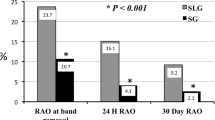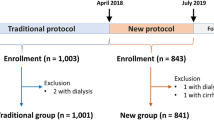Abstract
Some studies have suggested that radial access (RA) for percutaneous coronary intervention (PCI) reduces vascular complications and bleeding compared to femoral access (FA). The purpose of this study was to investigate the routine use of hemostatic devices and bleeding complications among RA, brachial access (BA), and FA. Between January 2015 and December 2015, 298 patients treated for PCI with RA were compared with 158 patients using BA and 206 patients using FA. The radial sheath was routinely removed with ADAPTY, the brachial sheath with BLEED SAFE, and the femoral sheath with Perclose ProGlide. In-hospital bleeding complications were investigated. Cardiogenic shock was most frequent in patients in the femoral group (RA 1.3%, BA 2.5%, FA 9.2%, p < 0.0001). The rate of major bleeding was highest in the femoral group (RA 1.0%, BA 2.5%, FA 5.3%, p = 0.01). Blood transfusion rates were highest in the femoral group (RA 0.7%, BA 1.3%, FA 4.4%, p = 0.01). Retroperitoneal bleeding was observed in 1.9% of patients in the femoral group. Patients in the brachial group had large hematomas (RA 0.7%, BA 4.4%, FA 1.5%, p = 0.01). Pseudoaneurysm formation needing intervention occurred most frequently in the brachial group (RA 0%, BA 1.3%, FA 0%, p = 0.04). In conclusion, compared to the brachial and femoral approaches, the radial approach appears to be the safest technique to avoid local vascular bleeding complications. The brachial approach has the highest risk of large hematoma and pseudoaneurysm formation among the three groups.



Similar content being viewed by others
Abbreviations
- PCI:
-
Percutaneous coronary intervention
- RA:
-
Radial access
- BA:
-
Brachial access
- FA:
-
Femoral access
- IABP:
-
Intraaortic balloon pump counterpulsation
- DAPT:
-
Dual antiplatelet therapy
- CABG:
-
Coronary artery bypass graft surgery
- BARC:
-
Bleeding Academic Research Consortium
- ARC:
-
Academic Research Consortium
- MI:
-
Myocardial infarction
- TLR:
-
Target lesion revascularization
- MACE:
-
Major adverse cardiac event
- NACE:
-
Net adverse clinical event
- CTO:
-
Chronic total occlusion
- PCPS:
-
Percutaneous cardiopulmonary support
References
Kugelmass AD, Cohen DJ, Brown PP, Simon AW, Becker ER, Culler SD. Hospital resources consumed in treating complications associated with percutaneous coronary interventions. Am J Cardiol. 2006;97:322–7.
Kinnaird TD, Stabile E, Mintz GS, Lee CW, Canos DA, Gevorkian N, et al. Incidence, predictors, and prognostic implications of bleeding and blood transfusion following percutaneous coronary interventions. Am J Cardiol. 2003;92:930–5.
Kiemeneij F, Laarman GJ, Odekerken D, Slagboom T, van der Wieken R. A randomized comparison of percutaneous transluminal coronary angioplasty by the radial, brachial and femoral approaches: the access study. J Am Coll Cardiol. 1997;29:1269–75.
Cooper CJ, El-Shiekh RA, Cohen DJ, Blaesing L, Burket MW, Basu A, et al. Effect of transradial access on quality of life and cost of cardiac catheterization: a randomized comparison. Am Heart J. 1999;138:430–6.
Valgimigli M, Gagnor A, Calabro P, Frigoli E, Leonardi S, Zaro T, et al. Radial versus femoral access in patients with acute coronary syndromes undergoing invasive management: a randomised multicentre trial. Lancet. 2015;385:2465–76.
Romagnoli E, Biondi-Zoccai G, Sciahbasi A, Politi L, Rigattieri S, Pendenza G, et al. Radial versus femoral randomized investigation in ST-segment elevation acute coronary syndrome: the RIFLE-STEACS (Radial Versus Femoral Randomized Investigation in ST-Elevation Acute Coronary Syndrome) study. J Am Coll Cardiol. 2012;60:2481–9.
Jolly SS, Yusuf S, Cairns J, Niemela K, Xavier D, Widimsky P, et al. Radial versus femoral access for coronary angiography and intervention in patients with acute coronary syndromes (RIVAL): a randomised, parallel group, multicentre trial. Lancet. 2011;377:1409–20.
Mann T, Cowper PA, Peterson ED, Cubeddu G, Bowen J, Giron L, et al. Transradial coronary stenting: comparison with femoral access closed with an arterial suture device. Catheter Cardiovasc Interv. 2000;49:150–6.
Brueck M, Bandorski D, Kramer W, Wieczorek M, Holtgen R, Tillmanns H. A randomized comparison of transradial versus transfemoral approach for coronary angiography and angioplasty. JACC Cardiovasc Interv. 2009;2:1047–54.
Ryan TJ, Faxon DP, Gunnar RM, Kennedy JW, King SB 3rd, Loop FD, et al. Guidelines for percutaneous transluminal coronary angioplasty. A report of the American College of Cardiology/American Heart Association Task Force on Assessment of Diagnostic and Therapeutic Cardiovascular Procedures (Subcommittee on Percutaneous Transluminal Coronary Angioplasty). Circulation. 1988;78:486–502.
Ochiai M, Sakai H, Takeshita S, Yonashiro T, Ozumi K, Maruyama Y, et al. Efficacy of a new hemostatic device, Adapty, after transradial coronary angiography and intervention. J Invasive Cardiol. 2000;12:618–22.
Mehran R, Rao SV, Bhatt DL, Gibson CM, Caixeta A, Eikelboom J, et al. Standardized bleeding definitions for cardiovascular clinical trials: a consensus report from the Bleeding Academic Research Consortium. Circulation. 2011;123:2736–47.
Cutlip DE, Windecker S, Mehran R, Boam A, Cohen DJ, van Es GA, et al. Clinical end points in coronary stent trials: a case for standardized definitions. Circulation. 2007;115:2344–51.
Agostoni P, Biondi-Zoccai GG, de Benedictis ML, Rigattieri S, Turri M, Anselmi M, et al. Radial versus femoral approach for percutaneous coronary diagnostic and interventional procedures; Systematic overview and meta-analysis of randomized trials. J Am Coll Cardiol. 2004;44:349–56.
Bertrand OF, Belisle P, Joyal D, Costerousse O, Rao SV, Jolly SS, et al. Comparison of transradial and femoral approaches for percutaneous coronary interventions: a systematic review and hierarchical Bayesian meta-analysis. Am Heart J. 2012;163:632–48.
Jolly SS, Amlani S, Hamon M, Yusuf S, Mehta SR. Radial versus femoral access for coronary angiography or intervention and the impact on major bleeding and ischemic events: a systematic review and meta-analysis of randomized trials. Am Heart J. 2009;157:132–40.
Parviz Y, Rowe R, Vijayan S, Iqbal J, Morton AC, Grech ED, et al. Percutaneous brachial artery access for coronary artery procedures: feasible and safe in the current era. Cardiovasc Revasc Med. 2015;16:447–9.
Acknowledgements
We would like to thank Editage (http://www.editage.jp) for English language editing.
Author information
Authors and Affiliations
Corresponding author
Ethics declarations
Ethical approval
All procedures performed in studies involving human participants were in accordance with the ethical standards of the institutional and/or national research committee and with the 1964 Helsinki declaration and its later amendments or comparable ethical standards.
Informed consent
Informed consent was obtained from all individual participants included in the study.
Sources of funding
There is no study sponsor.
Conflict of interest
All authors have nothing to disclose.
Rights and permissions
About this article
Cite this article
Otsuka, M., Shiode, N., Nakao, Y. et al. Comparison of radial, brachial, and femoral accesses using hemostatic devices for percutaneous coronary intervention. Cardiovasc Interv and Ther 33, 62–69 (2018). https://doi.org/10.1007/s12928-016-0439-4
Received:
Accepted:
Published:
Issue Date:
DOI: https://doi.org/10.1007/s12928-016-0439-4




